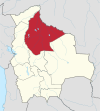Loreto, Beni
You can help expand this article with text translated from the corresponding article in German. (December 2010) Click [show] for important translation instructions.
- View a machine-translated version of the German article.
- Machine translation, like DeepL or Google Translate, is a useful starting point for translations, but translators must revise errors as necessary and confirm that the translation is accurate, rather than simply copy-pasting machine-translated text into the English Wikipedia.
- Do not translate text that appears unreliable or low-quality. If possible, verify the text with references provided in the foreign-language article.
- You must provide copyright attribution in the edit summary accompanying your translation by providing an interlanguage link to the source of your translation. A model attribution edit summary is
Content in this edit is translated from the existing German Wikipedia article at [[:de:Loreto (Beni)]]; see its history for attribution. - You may also add the template
{{Translated|de|Loreto (Beni)}}to the talk page. - For more guidance, see Wikipedia:Translation.
Place in Beni Department, Bolivia
15°11′34″S 64°45′32″W / 15.19278°S 64.75889°W / -15.19278; -64.75889 Bolivia
Bolivia Beni Department
Beni Department (2001)
Loreto is a smalI municipality in the Beni Department in northern Bolivia, capital of the Marbán Province and Loreto Municipality.[1] In 2001, Loreto had a population of 843.
History
Loreto was the first of the Jesuit Missions of Moxo to be founded. Loreto Mission was founded in 1682.[2]
Languages
Camba Spanish is the primary vernacular lingua franca spoken in the town. Loretano, a Moxo dialect, is the main indigenous language spoken.[3][4]
References
- ^ Observatorio de la Bolivia Democrática (OBD)[permanent dead link]
- ^ Block, David (1994). Mission culture on the upper Amazon: native tradition, Jesuit enterprise, and secular policy in Moxos, 1660-1880. Lincoln}publisher=University of Nebraska Press. ISBN 0-8032-1232-1.
{{cite book}}: CS1 maint: location missing publisher (link). - ^ Danielsen, Swintha (2011). The personal paradigms in Baure and other South Arawakan languages. In Antoine Guillaume; Françoise Rose (eds.). International Journal of American Linguistics 77(4): 495-520.
- ^ Danielsen, Swintha; Terhart, Lena (2014). Paunaka. In Mily Crevels; Pieter Muysken (eds.). Lenguas de Bolivia, vol. III: Oriente, pp. 221-258. La Paz: Plural Editores.
External links
- Satellite map at Maplandia.com
- v
- t
- e
 Beni Department
Beni DepartmentCapital: La Santísima Trinidad

and seats
- Baures (Baures)
- Exaltación (Exaltación)
- Guayaramerín (Guayaramerín)
- Huacaraje (Huacaraje)
- Loreto (Loreto)
- Magdalena (Magdalena)
- Puerto Siles (Puerto Siles)
- Reyes (Reyes)
- Riberalta (Riberalta)
- Rurrenabaque (Rurrenabaque)
- San Andrés (San Andrés)
- San Borja (San Borja)
- San Ignacio (San Ignacio)
- San Javier (San Javier)
- San Joaquín (San Joaquín)
- San Ramón (San Ramón)
- Santa Ana (Santa Ana del Yacuma)
- Santa Rosa (Santa Rosa)
- Trinidad (Trinidad)
This Beni Department location article is a stub. You can help Wikipedia by expanding it. |
- v
- t
- e











